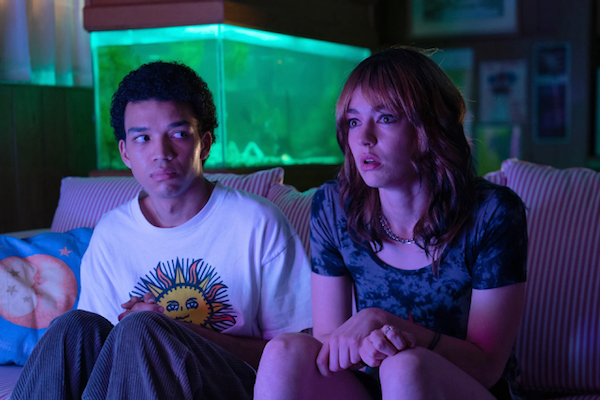Movie review by Greg Carlson
In their previous feature, the 2021 Sundance Film Festival Next selection “We’re All Going to the World’s Fair,” director Jane Schoenbrun shaped the raw materials of electronically-mediated internet communication to explore thresholds, boundaries, and the construction of identities. “I Saw the TV Glow,” while no less raw and unsettling, marks a significant step in the filmmaker’s evolution, shifting from the more directly participatory and interactive dynamics of the creepypasta-influenced “World’s Fair Challenge” to the obsessive cult fandom inspired by television shows such as “Twin Peaks” and “Buffy the Vampire Slayer.” An ambitious and thoughtful experience driven by two strong central performances, “I Saw the TV Glow” is adventurous and thought-provoking cinema.
While accompanying his mother to the polls for the 1996 presidential election, Owen (played briefly as a middle-schooler by Ian Foreman and then as an older teen and adult by Justice Smith) spots Maddy (Brigette Lundy-Paine) reading a paperback episode guide to the late-night YA fantasy series “The Pink Opaque.” A strange tale of two girls with psychic abilities, the compelling serial features evil clowns, living ice cream treats, and monstrous characters like “big bad” Mr. Melancholy, whose looks are inspired by the lunar visage from “A Trip to the Moon” by way of the Smashing Pumpkins. Although he has not yet been able to watch (“The Pink Opaque” airs after his bedtime), Owen cooks up a plan to join Maddy for weekend screenings. Maddy also obsessively tapes the show on VHS.
The rituals of devotion practiced by Owen and Maddy will be familiar to viewers who treated (and continue to treat) “Twin Peaks” like the foundational scripture of a deeply-felt religious denomination. Schoenbrun uses the show-within-the-show to reflect and refract the experiences of Owen and Maddy in a manner reminiscent of how the soap opera “Invitation to Love” fueled the imaginations of characters appearing in “Twin Peaks” and functioned as a commentary on the principal melodrama. In another of the movie’s homages to the imagination of David Lynch, live musical performances take place at a spot called the Double Lunch in parallel to the showcases at the Bang Bang Bar/Roadhouse in “Twin Peaks.”
In the press notes for the film, Schoenbrun candidly discusses their intention for “I Saw the TV Glow” to address what is called the “egg crack” – “the pivotal moment when a person first realizes they are trans.” Multiple observers have praised Schoenbrun for the sophisticated depiction of such a complex experience; the intensely personal is rendered here with uniqueness and specificity for the characters while conveying something universal and human for all audience members. Schoenbrun chooses not to develop parasocial interactions and relationships between Owen and Maddy and the protagonists of “The Pink Opaque,” avoiding a pitfall that routinely trips up filmmakers who play with the show-within-the-show conceit.
The decision proves especially wise as one of the wonders of “I Saw the TV Glow” unfolds when memories of “The Pink Opaque” don’t align in the ways anticipated by Owen when he revisits the series as an older person. Schoenbrun even embraces the humor amidst this pain, inviting viewers to laugh at the revised glimpse of something that at one time was so whole and so meaningful. It is just one among many of the movie’s instances of dysphoric fracturing that accompanies what Schoenbrun notes is the desire to “figure out a way to be yourself in a world that has done a really good job of trying to convince you that you’re someone else.”
